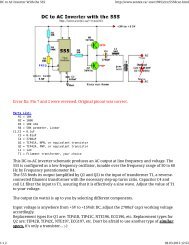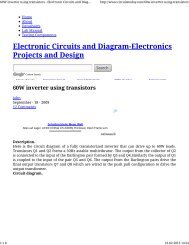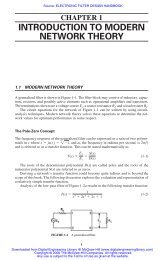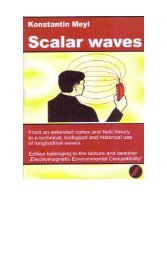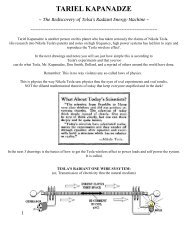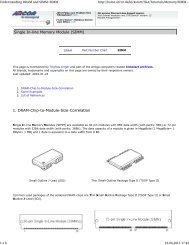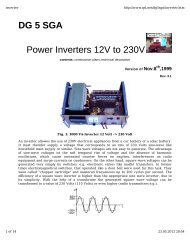- Page 3: COMMUNICATIONS,RADAR ANDELECTRONICW
- Page 7: Content,6.3 Types of Communications
- Page 10 and 11: xContents16.1.2 EMC Issues 26616.1.
- Page 12 and 13: xiiContents20 Summary and Conclusio
- Page 14 and 15: xivPrefaceI have provided some refe
- Page 16 and 17: ",iDiplexerdBddBiOEMOFDMEDownlinkDR
- Page 18 and 19: xviiiGlos&aryNFDNSAOPOPTEMPOORE ATO
- Page 21: Part OneBasic Theory
- Page 24 and 25: 4 CommunicatIOns, Radar and Electro
- Page 28 and 29: 8Communications, Radar and Electron
- Page 30 and 31: 10 Communications, Radar and Electr
- Page 32 and 33: ..N(')o33'"2.(")o·::l.
- Page 34 and 35: 14 Communicatiom, Radar and Electro
- Page 36 and 37: 16Communications, Radar and Electro
- Page 38 and 39: ] 8COmmUlllCatlOns, Radar and Elect
- Page 40 and 41: ZOCOlllllllll1lldliollS. R"d"l .!ll
- Page 42 and 43: 22 CommunicatIOns, Radar and Electr
- Page 44 and 45: 24 Communications, Radar and Electr
- Page 46 and 47: 26 Communications, Radar and Electr
- Page 48 and 49: 2Xh;IS hccn in cxistcncc slncc thc
- Page 50 and 51: 30 Communications, Radar and Electr
- Page 52 and 53: 32 Communications, Radar and Electr
- Page 54 and 55: 34 Communications, Radar and Electr
- Page 56 and 57: 36 Communications, Radar and Electr
- Page 58 and 59: 38ommuOlC3l10ns. Radar andlectroOlc
- Page 60 and 61: 40 Communications, Radar and Electr
- Page 62 and 63: 42 Communications, Radar and Electr
- Page 65 and 66: 3The Radio Channel3.1 Frequency Asp
- Page 67 and 68: The Radio Channel471000Wavelength (
- Page 69 and 70: The Radio Channel 49sphere. An isot
- Page 71 and 72: The Radio Channel51E6(J)()c.l'l(f)o
- Page 73 and 74: The Radio ChannelU BUilding- - Rad
- Page 75 and 76: The Radio Channel 55The Cumulative
- Page 77 and 78:
The Radio Channel 57caused by refle
- Page 79 and 80:
The Radio Channel59Timeslot #1 ,f l
- Page 81 and 82:
The Radio Channel61105o41-5-10-15-2
- Page 83:
The Radio Channel 63References and
- Page 86 and 87:
66 Communications, Radar and Electr
- Page 88 and 89:
68 Communications, Radar and Electr
- Page 90 and 91:
70Communications, Radar and Electro
- Page 92 and 93:
72Communications, Radar and Electro
- Page 94 and 95:
74 Communications, Radar and Electr
- Page 96 and 97:
76 Communications, Radar and Electr
- Page 99 and 100:
5Radio Links in the Presence ofInte
- Page 101 and 102:
Radio Links in the Presence of Inte
- Page 103 and 104:
Radio Links in the Presence of Inte
- Page 105 and 106:
Radio Links in the Presence of Inte
- Page 107 and 108:
Radio Links in the Presence of Inte
- Page 109 and 110:
Radio Link
- Page 111 and 112:
Radio Links in the Presence of Inte
- Page 113 and 114:
Radio Links in the Presence of Inte
- Page 115 and 116:
6Radio Links and DeliberateJamming6
- Page 117 and 118:
Radio Links and Deliberate Jamming9
- Page 119 and 120:
Radio Links and Deliberate Jamming9
- Page 121 and 122:
102 Communication, Radar and Electr
- Page 123 and 124:
----_. - - ._.----- ---7.2 The Raci
- Page 125 and 126:
106 Communications, Radar and Elect
- Page 127 and 128:
108 Communications, Radar and Elect
- Page 129 and 130:
----110Communications, Radar and El
- Page 131 and 132:
J J 2----. . --------- .. ---"!6o.D
- Page 133 and 134:
114Communications, Radar and Electr
- Page 135 and 136:
116 Communications, Radar and Elect
- Page 137 and 138:
118 Communications, Radar and Elect
- Page 139 and 140:
120Communications, Radar and Electr
- Page 141 and 142:
122Communications, Radar and Electr
- Page 143 and 144:
124Communications, Radar and Electr
- Page 145 and 146:
126 Communications, Radar and Elect
- Page 147 and 148:
I2XCommunications. Radar and Electr
- Page 149 and 150:
130 Communications, Radar and Elect
- Page 151 and 152:
132 Commul11calion, Radar and Elect
- Page 154 and 155:
8Radio-Controlled ImprovisedExplosi
- Page 156 and 157:
Radio-Controlled Improvised Explosi
- Page 158 and 159:
Radio-Controlled Improvised Explosi
- Page 160 and 161:
Radio-Controlled Improvised Explosi
- Page 162 and 163:
Radio-Controlled Improvised Explosi
- Page 164:
Part TwoPractical
- Page 167 and 168:
148 Communications, Radar and Elect
- Page 169 and 170:
150 Communications, Radar and Elect
- Page 171 and 172:
152Communications, Radar and Electr
- Page 173 and 174:
154Communications, Radar and Electr
- Page 175 and 176:
156 Communications, Radar and Elect
- Page 177 and 178:
158 Commul1lcations, Radar and Elec
- Page 179 and 180:
160 Communications, Radar and Elect
- Page 181 and 182:
162 Communications, Radar and Elect
- Page 183 and 184:
164CommunicatIOns, Radar and Electr
- Page 185 and 186:
166Communications, Radar and Electr
- Page 187 and 188:
168 Communications, Radar and Elect
- Page 189 and 190:
170 Communications, Radar and Elect
- Page 191 and 192:
172 Communications, Radar and Elect
- Page 193 and 194:
174 Communications, Radar and Elect
- Page 195 and 196:
176 Communications, Radar and Elect
- Page 197 and 198:
InCOlllllllllliLdllllllS. R.ltidl'
- Page 199 and 200:
180 CommullIcations, Radar and Elec
- Page 201 and 202:
182 Communications, Radar and Elect
- Page 203 and 204:
184 Communications, Radar and Elect
- Page 205 and 206:
186 Communication:" Radar and Elect
- Page 207 and 208:
188 CommunicatIOns, Radar and Elect
- Page 209 and 210:
190 Communications, Radar and Elect
- Page 211 and 212:
192 COIl1Il1UI1IC;llIOIlS. Rauar an
- Page 213 and 214:
...()o§c:::l;:; .o·::lY''"I>l::l0
- Page 215 and 216:
..'CQ'I()o33c:lriOo·:lY':::0'"0-§
- Page 217 and 218:
..'C00no§c::>('ig:>i";:0:>0-tTl()a
- Page 219 and 220:
Noo(")o33c:::lno·::lY'0.C»::l0.tT
- Page 221 and 222:
202 Communications, Radar and Elect
- Page 223 and 224:
204Communications, Radar and Electr
- Page 225 and 226:
206Communications, Radar and Electr
- Page 227 and 228:
208 Communications, Radar and Elect
- Page 229 and 230:
210 Communications, Radar and Elect
- Page 231 and 232:
212 Communications, Radar and Elect
- Page 233 and 234:
214 Communications, Radar and Elect
- Page 235 and 236:
..216 Communicati ons, Radar and El
- Page 237 and 238:
218Communi15Gaseous absorptionE.!I!
- Page 240 and 241:
12Planning and OptimisingRadio Link
- Page 242 and 243:
Planning and Optimising Radio Links
- Page 244 and 245:
Planning and Optimising Radio Links
- Page 246:
"""'"'Planning and Optimising Radio
- Page 249 and 250:
..230Communications, Radar and Elec
- Page 251 and 252:
232 Communications, Radar and Elect
- Page 253 and 254:
234 Communications, Radar and Elect
- Page 255 and 256:
236Communications, Radar and Electr
- Page 257 and 258:
NtHocno33c:::l(;o::l.m;;0'"0-'"::l0
- Page 259 and 260:
"..Base.. .ie StationWanted=no33t::
- Page 261 and 262:
242 CommunIcations, Radar and Elect
- Page 263 and 264:
244 Communications, Radar and Elect
- Page 265 and 266:
246 Communications, Radar and Elect
- Page 267 and 268:
248Communication , Radar and Electr
- Page 269 and 270:
250Communications, Radar and Electr
- Page 271 and 272:
252 Communication5, Radar and Elect
- Page 273 and 274:
254 Communications, Radar and Elect
- Page 276 and 277:
15Management Techniquesfor Interfer
- Page 278 and 279:
Management Techniques for Interfere
- Page 280 and 281:
Management Teehnlljues for Interfer
- Page 282 and 283:
Management Techniques for Interfere
- Page 284 and 285:
16Management of Interferenceat a Ra
- Page 286 and 287:
Management of Interference at a Rad
- Page 288 and 289:
Management of Interference at a Rad
- Page 290 and 291:
Management of Interference at a Rad
- Page 292 and 293:
Management of Interference at a Rad
- Page 294:
Management of Interference at a Rad
- Page 297 and 298:
CommUnIcatIOns Electronic Warfare27
- Page 299 and 300:
Communications Electronic Warfare28
- Page 301 and 302:
CommUnicatIOns Electronic Warfare28
- Page 303 and 304:
Communications Electronic Warfare28
- Page 305 and 306:
Communications Electronic Warfare28
- Page 307 and 308:
Co mmUnICatIOn> ElectronIc Warfare2
- Page 309 and 310:
Communications Electronic Wrufare 2
- Page 311 and 312:
Communications Electronic Warfare 2
- Page 313 and 314:
Communications Electronic Warfare 2
- Page 315 and 316:
Communications Electromc Warfare297
- Page 317 and 318:
Communications Electronic Warfare 2
- Page 319 and 320:
CommentSy
- Page 321 and 322:
CommunicatlOm Electronic Warfare303
- Page 323 and 324:
Communications Electronic Warfare30
- Page 325 and 326:
Communications Electronic Warfare30
- Page 327 and 328:
Communications Electronic Warfare30
- Page 329 and 330:
Communicatiom Electrol1JC Warfare 3
- Page 331 and 332:
Communications Electronic Warfare 3
- Page 333 and 334:
Communications Electromc Warfare 31
- Page 335 and 336:
Communications Electronic Warfare 3
- Page 337 and 338:
---COIlllll unlcalions Electronic \
- Page 339 and 340:
Communications Electronic Warfare 3
- Page 341 and 342:
Communications Electronic Warfare 3
- Page 343:
Communications Electronic Warfare 3
- Page 346 and 347:
328CommunicatIOns. Radar and Electr
- Page 348 and 349:
330Communications, Radar and Electr
- Page 350 and 351:
332 Communications, Radar and Elect
- Page 352 and 353:
(tlllllIlllllIc.IIIIIII' 16ClUOJ:::
- Page 354 and 355:
336 Communication, Radar and Electr
- Page 356 and 357:
338 Communications, Radar and Elect
- Page 358 and 359:
340 Communications, Radar and Elect
- Page 360 and 361:
342 Communications, Radar and Elect
- Page 362 and 363:
344 CommullIcations, Radar and Elec
- Page 364 and 365:
346 Communication,>, Radar and Elec
- Page 366 and 367:
348 Communication'>, Radar and Elec
- Page 368 and 369:
350 Communications, Radar and Elect
- Page 370 and 371:
352 Communications, Radar and Elect
- Page 372 and 373:
354 Communicationb, Radar and Elect
- Page 374 and 375:
356 CommunicatIOns, Radar and Elect
- Page 376 and 377:
358 CommunicatIOns, Radar and Elect
- Page 378 and 379:
360 Communications, Radar and Elect
- Page 380 and 381:
362 CommunicatIOns. Radar and Elect
- Page 383 and 384:
20Summary and ConclusionsI have tri
- Page 385 and 386:
Appendix A: Workingwith DecibelsThi
- Page 387 and 388:
Appendix B: Common ConversionFormul
- Page 389 and 390:
Appendix B: Common Conversion Formu
- Page 391:
Appendix B: Common Conversion Formu
- Page 394 and 395:
376IndexDF coverage 309Direction fi
- Page 396:
Indn- -- --- - --- --pi llhability



